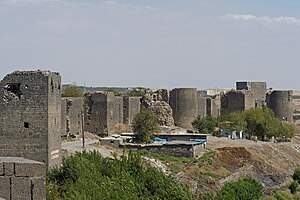| Siege of Amida | |||||||||
|---|---|---|---|---|---|---|---|---|---|
| Part of the Perso-Roman wars of 337–361 | |||||||||
 The walls of Amida, built by Constantius II before the siege of 359 | |||||||||
| |||||||||
| Belligerents | |||||||||
| Sasanian Empire and allies | Eastern Roman Empire | ||||||||
| Commanders and leaders | |||||||||
|
Shapur II or Peroz Tamshapur Grumbates Urnayr |
Aelianus Sabinianus Ursicinus | ||||||||
| Units involved | |||||||||
|
Sassanian army Xionites Gelani Albani Segestani |
Legio V Parthica and an unnamed cavalry unit (garrison) Legio XXX Ulpia A detachment of Legio X Fretensis Tricensimani Decimani Superventores and Praeventores (light cavalry) Comites Sagittarii (Household mounted archers) Magnentiaci and Decentiaci (legions from Gaul loyal to Magnentius) | ||||||||
| Strength | |||||||||
| c. 100,000[3] |
| ||||||||
| Casualties and losses | |||||||||
| c. 30,000 dead[6] | Most defenders, some citizens, some refugees from countryside[6] | ||||||||
Location of the Siege of Amida | |||||||||
The siege of Amida was a military investment of the Roman fortified frontier city of Amida (modern Diyarbakır, Turkey) by the Sasanian Empire. It took place in AD 359 when the Sasanian army under king Shapur II invaded the eastern provinces of the Roman Empire. Shapur wanted to exploit the absence of the Roman Emperor Constantius II who was overseeing affairs in the western part of the Empire. The city fell, but the strategic gain was little.
Ammianus Marcellinus, a Roman army officer, provided a vivid description of the siege in his work (Res Gestae). Ammianus served on the staff of Ursicinus, the Magister Equitum (master of horse) of the East, during the events of the siege.[7]
- ^ From Constantine to Julian: Pagan and Byzantine Views: A Source History "359 (oct.) Amida fell to Shapur after a long siege of seventy-three days."
- ^ Ammianus Marcellinus (1982). Res Gestae. Cambridge, MA: Harvard University Press. pp. 18.8.2.
- ^ a b John Harrel, Nisibis War, p. 156.
- ^ Crawford, Peter (2016). Constantius II: Usurpers, Eunuchs, and the Antichrist. Pen & Sword. p. 169.
- ^ Sellwood, D. (2011). "AMIDA". Encyclopaedia Iranica, Vol. I, Fasc. 9. p. 938.
- ^ a b Ammianus Marcellinus. Res Gestae. pp. 19.9.9.
- ^ John Harrel, Nisibis War, p. 148.

